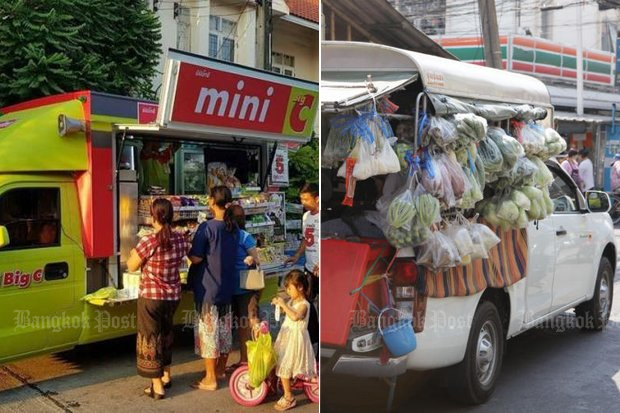
The launch of Big C Supercenter's mobile grocery trucks has caused a stir, with many voicing concerns over the adverse effect on the traditional mobile vehicles or food trucks run by small-scale operators.
Such concerns are valid. There will be some impact, though I think it will be more or less gradual, not so intense like that of the convenience stores that have largely wiped out the mom-and-pop grocery shops -- at least in the beginning stage. This means there is still time for the traditional operators to adapt.
The impact of the retail giant's mobile stores is limited because in the food truck trade, there exists a kind of bond between the operators and their customers who personally engage in healthy interaction. Such a bond will continue to be a deciding factor for this old trade, and most customers will remain loyal to the traditional type, not hastily switching to the superstore's new trucks right away.

Decharut Sukkumnoed is head of Kasetsart University's Agricultural and Resource Economics Department. He is well-known for his civic role.
The healthy interaction goes beyond typical greetings. Traditional truck operators know their patrons well enough and, with flexibility, can serve and cater to their demands -- what they particularly want, the prices they can afford. The system allows patrons to make advance orders for specific goods, etc. Such interaction will be a key to the truck operators' survival.
It should be noted that, unlike retail business, the display and image of the Big C Mini trucks at this stage do little to attract customers who are still acquainted with the old buying system in which they make orders, then the operators efficiently answer to respective demand, reaching for each particular item for the buyers.
However, there is a possibility that customers will change their buying behaviour, being attracted to the display or image of the Big C trucks, plus the goods selection by the superstore's standards.
For this reason, it's necessary that the old food trucks find ways to intensify their strength to face the challenge. Their strength lies in the diversity of Thailand's food supply chain, which gives them a chance to compete with the retail giant. They can stay in the competition as long as they are able to fill the orders with friendly prices. This also means paying more attention to product quality to maintain the customer base.
But the impact of Big C mobile stores can be drastic under two circumstances.
The first involves promotional tactics like point collection. Once the superstore's trucks allow customers to gain points for each purchase, they will get more customers and this will make it harder for traditional trucks to compete.
Secondly, superstore trucks can attract more customers if they offer counter service, like that of convenience stores, enabling customers to pay bills for other services.
But a deciding factor will be the ability to satisfy customers by finding the items they want in the goods supply chain. If traditional food trucks focus on quality, adding healthy items like organic produce and toxin-free goods to the list, they can still compete.
Not long from now, however, we will see traditional trucks upgrade their look, with services improved in a bid to keep customers. We will also see some new faces, particularly people of the younger generation, not other retail giants, in the market.
Very likely, the trucks run by young people will offer ready-to-eat or ready-to-cook food items that come in sukiyaki-like sets for khao yam (a southern dish of cooked rice, a variety of vegetables and boodoo dressing) or khanom jeen (noodles made of fermented flour with fish curry).
Each set could offer options like more vegetable variety. They will pay more attention to packaging and the look of the product. Some may make use of technology, allowing customers to make advance orders through an application.
If traditional food trucks can adjust, operating like those franchise chains with a kind of delivery service, they will thrive. For instance, if I am a baker, I will post my products online and when I get an order, I will join with food truck operators so they can deliver those orders along their routes for a delivery charge.
It would be helpful if those involved organised a workshop to design new looks for traditional food trucks, plus additional services that they may accommodate. Financial institutions should be asked to provide low-interest loans for traditional food truck operators who want to change or upgrade their look to suit new patrons' tastes. Those institutions, at the same time, may provide training to the truck operators to enable them to operate, in the same way that their micro units offer financial access to grass-roots economic groups.
With adaptation, there is a chance that traditional food trucks will emerge the winners.
